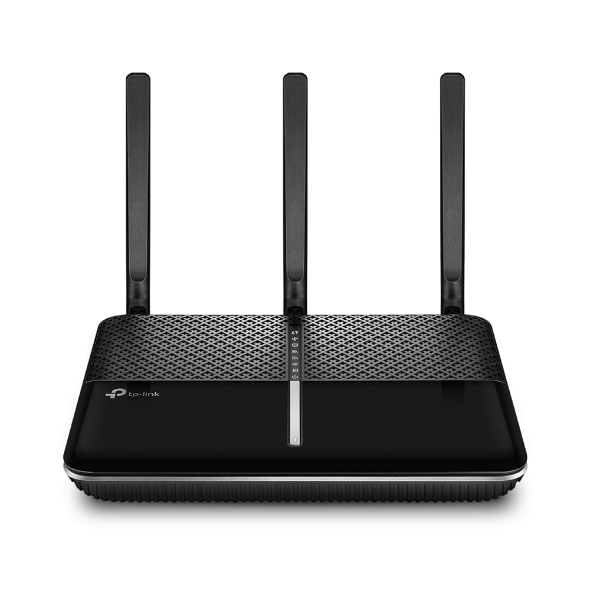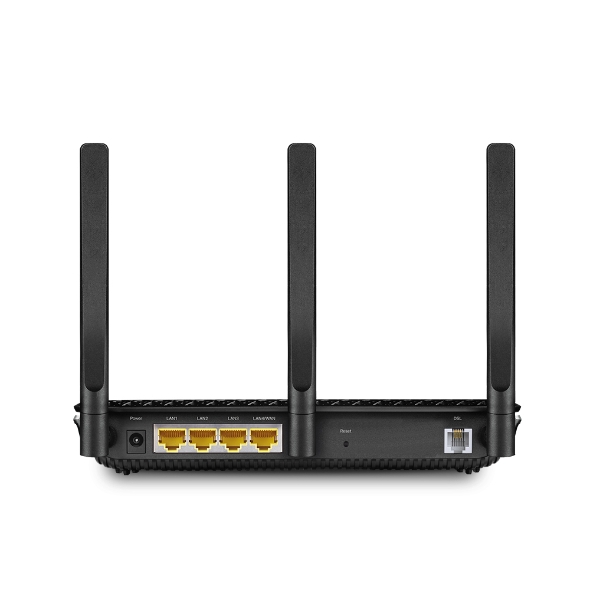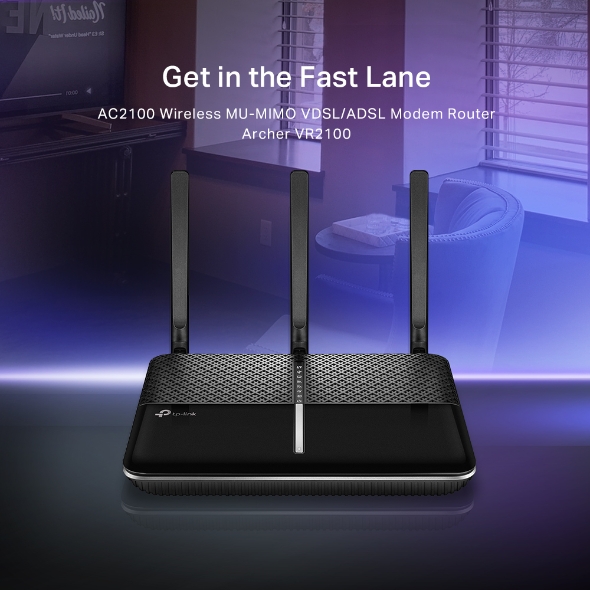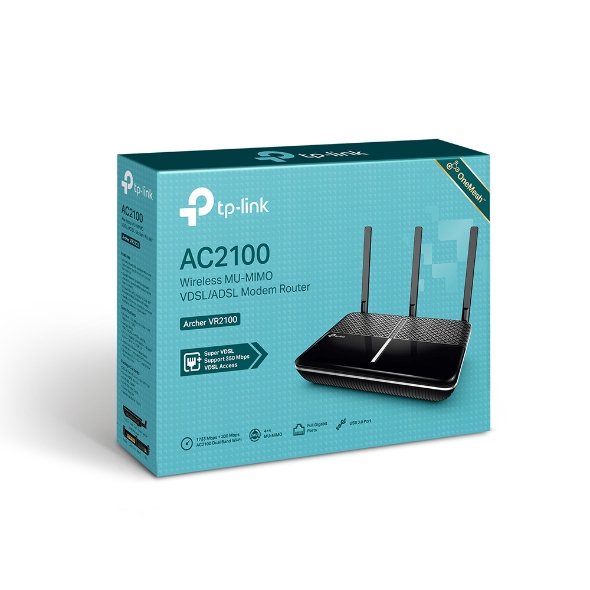Archer VR2100
AC2100 Wireless MU-MIMO VDSL/ADSL Modem Router
- Super VDSL – The Latest Super VDSL (VDSL2 Profile 35b) tech delivers internet speeds of up to 350 Mbps
- Ultra-Fast Speed –Surpasses the Wi-Fi speed limits of the previous generation, reaching up to 1733 Mbps on 5 GHz and 300 Mbps on 2.4 GHz
- 4×4 MU-MIMO – Simultaneously transfers data to multiple devices for 4x faster performance
- Whole-Home Coverage with OneMeshTM – Co-works with TP-Link OneMesh products to create a flexible and cost-efficient Mesh network
- Lightning-Fast Wired Connection – USB 3.0 port and four Gigabit Ethernet ports run up to 10x faster than the previous generation to unleash your home entertainment
- TP-Link Tether App – Easily access and manage your network, including remote control and automatic updates, using any iOS or Android mobile device.
| CARACTERÍSTICAS DE HARDWARE | |
|---|---|
| Interface | 3 Gigabit LAN Ports, 1 Gigabit LAN/WAN Port, 1 RJ11 Port,1 USB Port |
| Botón | WPS Button, Reset Button, Power On/Off Button, Wi-Fi Button, LEDOn/Off Button |
| Fuente de Alimentación Externa | 12V/1.5A |
| Estándares IEEE | IEEE 802.3, IEEE 802.3u, 802.3ab |
| Estándares VDSL2 | ITU G.993.2, Up to 35b profile (POTS)ITU-T G.993.5 (G.vector)ITU-T G.998.4 (G.INP) |
| Estándares ADSL | Full-rate ANSI T1.413 Issue 2,ITU-T G.992.1(G.DMT),ITU-T G.992.2(G.Lite), |
| Estándares ADSL2 | ITU-T G.992.3 (G.DMT.bis), |
| Estándares ADSL2+ | ITU-T G.992.5 |
| Dimensiones (W X D X H) | 8.5 × 6.5 × 1.4 in (216 × 164 × 36.8 mm) |
| Antena | 3 External Dual Band Antennas + 1 Internal 5 GHz Antenna |
| CARACTERÍSTICAS INALÁMBRICAS | |
|---|---|
| Estándares Inalámbricos | IEEE 802.11ac/n/a 5 GHz, IEEE 802.11b/g/n 2.4 GHz |
| Frecuencia | 2.4 GHz and 5 GHz |
| Tasa de Señal | 1733 Mbps on 5 GHz, 300Mbps on 2.4 GHz |
| Funciones Inalámbricas | Enable/Disable Wireless Radio, Wireless Statistics |
| Seguridad Inalámbrica | 64/128-bit WEP, WPA/WPA2, WPA-PSK/WPA-PSK2encryptions |
| Potencia de Transmisión | <20dBm (2.4 GHz), <23dBm (5 GHz) |
| Calendarizar Inalámbricamente | Support 2.4 GHz and 5 GHz Wireless Schedule |
| CARACTERÍSTICAS DE SOFTWARE | |
|---|---|
| Características Avanzadas | Parental Controls, Network Address Translation (NAT), StaticRouting, DNS Relay, DDNS, IGMP V1/V2/V3 |
| Seguridad | NAT Firewall, SPI Firewall, Access Control, Service Filtering, Denial of Service (DoS), SYN Flooding, Ping of Death, IP and MAC Address Binding |
| Modos de Funcionamiento | VDSL/ADSL Modem Router, 3G/4G Router, Wireless Router |
| Administración | Web-Based Configuration (HTTP / HTTPS ), Remote management,Command Line Interface, SSL for TR-069, SNMP v1/2c, Firmware Upgrade, Diagnostic Tools, Free Online Firmware Update |
| DHCP | Server, Client, DHCP Client List, Address Reservation, DHCP Relay |
| Port Forwarding | Virtual Server, Port Triggering, DMZ, ALG, UPnP |
| Dynamic DNS | DynDns, NO-IP, TP-Link |
| VPN | OpenVPN, PPTP VPN, IPSec VPN |
| Protocolos | Supports IPv4 and IPv6 |
| ATM/PPP Protocols | ATM Forum UNI3.1/4.0, PPP over ATM (RFC 2364), PPP overEthernet (RFC2516), IPoA (RFC1577/2225), MER\IPoE (RFC 1483 Routed), Bridge (RFC1483 Bridge), PVC – Up to 8 PVCs |
| Red de invitados | 2.4 GHz Guest Network, 5 GHz Guest Network |
| IPSec VPN | Supports up to 10 IPSec VPN tunnels |
| Otros | |
|---|---|
| Certificacion | CE, RCM, RoHS |
| Contenidos del Paquete | DSL Modem RouterExternal SplitterRJ11 DSL CableRJ45 Ethernet CablePower AdapterQuick Installation Guide |
| Requisitos del Sistema | Microsoft Windows 98SE, NT, 2000, XP, Vista™ or Windows 7, 8, 8.1, 10, Mac OS, NetWare, UNIX or LinuxInternet Explorer 11, Firefox 12.0, Chrome 20.0, Safari 4.0, or otherJava-enabled browserSubscription with an internet service provider (for internet access) |
| Ambiente | Operating Temperature: 0℃~40℃ (32℉ ~104℉)Storage Temperature: -40℃~70℃ (-40℉ ~158℉)Operating Humidity: 10%~90% non-condensingStorage Humidity: 5%~90% non-condensing |
† Maximum wireless signal rates are the physical rates derived from IEEE Standard 802.11 specifications. Range, coverage, and the maximum number of connected devices are based on test results under normal usage conditions. Actual wireless data throughput, wireless coverage, and number of connected devices are not guaranteed and will vary as a result of 1) environmental factors, including building materials, physical objects, and obstacles, 2) network conditions, including local interference, volume and density of traffic, product location, network complexity, and network overhead, and 3) client limitations, including rated performance, location, connection quality, and client condition.







